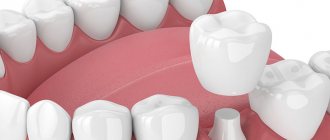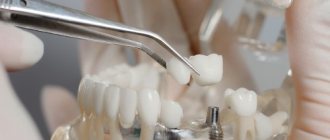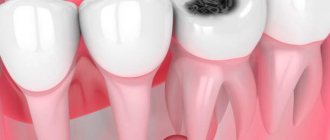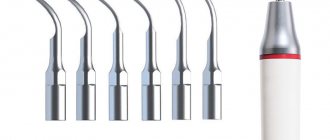One of the most popular services in any dental clinic is the installation of a filling. According to statistics, almost 85% of people need this procedure at least once in their lives. Timely filling allows you to stop the inflammatory process, stop further tissue destruction, and restore an attractive appearance to your smile. The most well-known ailment of the oral cavity, caries, is also the most common reason for having a filling installed. In advanced pathology, when the disease progresses to the stage of pulpitis and periodontitis, the root system also has to be treated. But even in this case, to mask the drilled penetration site, it is impossible to do without installing a seal. We invite everyone who needs high-quality fillings to the VivaDent clinic. Qualified doctors with extensive practical experience will quickly and painlessly install a reflective filling made from the latest generation of high-tech materials.
Navigation
- Filling materials
- Fillings or inlay?
- How does the installation work?
- Temporary and permanent plugs
- If the filling falls out
- Prices
Filling materials
A wide, sincere smile is an indicator of a person’s good mood and positive attitude. If there is a hole or chip in a tooth, then the first impression can easily be ruined, which can lead to problems in various areas of life. A high-quality filling installation will return charming aesthetics and prevent the development of dangerous pathologies. Teeth are not just a white row visible to others, but a complex system riddled with nerves and blood vessels. If any part fails, the entire mechanism becomes unusable. But installing a filling to plug the hole after treatment and sanitation can completely restore the aesthetic and chewing functions of the element. Plugs come in different sizes and shades - modern dentistry allows you to install a filling that is indistinguishable in color from your own enamel. However, the main quality criteria are strength, reliability and durability of the product. These properties depend on the raw materials used. The following materials are used to install the seal.
- Silicate cement is practically not used today. The material, well known to our mothers, quickly deteriorates, crumbles easily, and darkens under the influence of water.
- Amalgam is another obsolete option that is not popular due to its metallic tint and high mercury content.
- Plastic is a budget solution that is reliable, but has a tendency to change shade under the influence of dyes.
- Acrylic resin is a composition that causes increased pore formation, which often causes caries and pulpitis, leading to loss of the element.
- Ceramics is a durable material characterized by increased whiteness. Often used in aesthetic dentistry.
- Reflective composition is the most common option, hardening under the rays of a special lamp. It is distinguished by high reliability and excellent aesthetics.
- Glass ionomer cement is an innovative raw material based on polymer fibers. It has excellent adhesion and is used to treat caries and fill root canals.
INTERESTING! Dental treatment has been widely known since ancient times. In ancient times, fragments of cork tree bark were used to plug holes. In the era of Ancient Rome, healers installed fillings using foil and porcelain. Medieval healers filled the holes with molten lead.
Dental cements
Cement is a cheap material that has been used in dental practice for many years. Before the development of modern composites, 5 types of dental cements were used, three of them have serious disadvantages:
- Silicate ones are fragile, crumble quickly, and quite toxic.
- Zinc phosphate - shrink, so they are used only for gaskets.
- Silico-phosphate - do not adhere well to the edges of the formed cavity and wear out quickly.
Polycarboxylate cements contain fluoride, which strengthens teeth. Such cements are more reliable, but also crumble. Due to their low wear resistance, polycarboxylate cements are recommended for filling baby teeth.
Glass ionomer cements are the most durable and contain fluorine-aluminum silicate glass and polyacrylic acid. Used in the treatment of pulpitis and periodontitis as an intermediate filling. It closes the tooth cavity while there is a medicine inside that “kills” the nerve.
Filling or tab?
Many patients do not understand the difference between installing fillings and installing inlays. Let me explain. Filling is performed for average caries, if the affected area is not too large. Modern light-polymer products are attached to the walls after completion of therapeutic procedures using a special adhesive composition. Under the rays of a special lamp (hence the name), the semi-liquid substance quickly hardens, so that the filling can be installed in one visit to the doctor. A rich palette of colors allows you to choose the shade that best suits your own base. Inlays, most of which are made of ceramics, perform much broader functions. The elements restored in this way are distinguished by high strength, practicality, and durability. To the question “Which is better: installing a filling or an inlay?” It’s impossible to answer unequivocally; it all depends on specific goals. The decision is made by the doctor, but the tabs have a number of undeniable advantages:
- excellent aesthetics;
- high strength;
- long service life;
- favorable payback;
- no shrinkage;
- fissures are not trying.
ON A NOTE! If you need to install a filling inexpensively and quickly, without thinking about the future, then photopolymer materials are an excellent choice for any patient. However, if the teeth are prone to abrasion and the filling material often needs to be replaced, then inlays are more rational - because they do not require constant expansion of the carious cavity for sanitation and treatment.
Possible complications
The only trouble when treating uncomplicated caries is the gradual decrease in numbness. During this time, doctors recommend refusing to eat so as not to accidentally bite your tongue and gums.
If the dental intervention was deep, the disturbed tooth may ache for 1-2 days. This is the norm. To alleviate the condition, you can take a pain reliever.
Signs of complications after filling:
- aching pain >3 days;
- low-grade fever;
- intense pain that is not relieved by analgesics.
The cause of the symptoms is the development (progression) of inflammation due to improper installation of a filling, incorrectly selected material, or infection in an open tooth cavity. If signs of inflammation appear, you should contact your doctor.
How does the installation work?
Before any operation, including before installing a filling, the doctor takes an x-ray and studies the test results, which can be taken at any of the clinic’s branches. As a result, a treatment tactic is chosen, which is necessarily discussed with the patient. An agreement is concluded for the installation of a seal, the price of which will not change under any circumstances. If further treatment, prosthetics or implantation is required, doctors of related specialties are invited for consultation. Installing a filling after caries treatment is a simple process, but modern technologies require the doctor to have the highest skill and knowledge of the latest techniques. Thus, the sandwich technique is increasingly being used, in which glass ionomer cement is placed inside the canal, and a reflective filling is installed on top. This method not only protects the element from the penetration of harmful bacteria, but also strengthens hard tissues due to the high fluoride content. Installation includes the following steps.
- After the X-ray examination, the doctor administers local anesthesia. If the patient has allergies, treatment under general anesthesia is possible.
- Using a drill, the desired area is drilled. Different tips are used to penetrate the enamel and dentin to the pulp.
- Tissues affected by caries are removed; if the pulp is intact, it is disinfected. If necessary, a special protective gasket is used.
- The photopolymer material is applied layer by layer, in 2–3 layers. After each, drying with a lamp is mandatory.
- The finished product is sharpened and polished with a special apparatus to avoid damage to the tongue, cheeks, and lips. After this, the tooth is completely polished.
The process of installing a seal on video
IMPORTANT! In some cases, additional adjustment to the bite is necessary. The procedure allows you not to feel discomfort while chewing food. In some cases, the doctor invites you for a follow-up visit for observation and correction.
Anesthesia
Filling without anesthesia is possible when treating superficial caries, but even in this case, patients often ask to numb the area. If dental tissues are damaged deeper than the enamel, an anesthetic must be administered.
Types of anesthesia:
- Applique. Used to superficially reduce the sensitivity of tissues. A lidocaine-based spray, gel or ointment is applied to the causative area. The drugs are not absorbed into the blood and act for 20-30 minutes.
- Infiltration. Designed to suppress the sensitivity of the dental nerve and adjacent nerve fibers of the periodontal tissues. The anesthetic is administered by injection and lasts for 1 hour. In some cases, two-stage anesthesia is allowed. The first injection removes the excitability of the nerve endings of the pulp, the second one deprives the tissue of sensitivity.
- Conductor. It is used for deep anesthesia of several units of the dentition at once. The drug is administered not into the site of inflammation, but nearby. It lasts for 2-3 hours.
One of the types of conduction anesthesia is intraligamentous (intraligamentary) anesthesia. In this case, the injection is made with an ultra-thin needle into the periodontal tissue.
Dento-comfort dentists practice all types of pain relief and use safe anesthetics with clinically proven effectiveness.
Temporary and permanent plugs
The installation of temporary fillings has the main goal of isolating the cavity for the period of treatment of the disease. If previously this time was no more than 2-3 days, then the latest generation materials are able to retain their original properties for six months. The indication for temporary placement of a filling is a suspected diagnosis that requires confirmation. So, if the pain has not started, then the nerve is fine, you can install a permanent product. In addition, when the dental nerve is removed by killing and mummification, the hole is closed after applying the medicine. When the cavity is cleared of affected tissue, a permanent filling is installed. The requirements for temporary products are no less strict than for permanent ones, because during treatment it is necessary to exclude the slightest risk of penetration of bacteria and microbes from the outside. Therefore, they must be moisture-resistant, sealed, and plastic. When installing temporary and permanent fillings, different materials are used that meet the listed characteristics.
- For temporary ones: dentin paste based on petroleum jelly and glycerin, which has high plasticity and environmental safety; Vinoxol, which provides excellent adhesion; zinc-eugenol or polycarbosylate cement, characterized by excellent tissue compatibility and rapid survival.
- For permanent ones: the materials listed in the first section, the most popular of which is light-curing composite. It is perfect for installing fillings on the front teeth, because the main task of permanent products is to create an attractive smile. Nanocomposites are becoming increasingly widespread.
ATTENTION!
The installation of a good filling is invisible, durable, and reliable. This is especially true when working with chewing teeth, where the load is high. VivaDent clinic fully meet the criteria of strength and reliability .
Indications for filling
- Impaired functionality and shape of teeth.
- Invasive intervention in tooth tissue, dental canals.
- Elimination of aesthetic defects - chips, abrasion of enamel.
- Temporary sealing of medicinal or devitalizing drugs in the tooth cavity.
Our doctors
Kuzovleva Natalya Vladimirovna more than 15 years of experience Sign up
Radabova Nadezhda Bogdanovna experience more than 20 yearsSign up
Silkina Milana Vladimirovna experience more than 10 years Sign up
Dzhevelekis Sergey Yanisovich experience more than 10 yearsSign up
If the filling falls out
Proper installation of the seal eliminates the risk of it falling out. However, visitors come to our clinic complaining of similar cases after treatment in other places. Most often they occur due to the low qualifications of the doctor and the use of low-grade materials. Loss of tightness and the appearance of cracks at the filling site can also be caused by saliva getting into the treated area. Sometimes installing a filling is not suitable for a particular case at all: the carious cavity is too large, the plug cannot withstand the chewing load and falls out. The doctor should have chosen a different treatment method. In addition, natural shrinkage must be taken into account. If you install a filling without adjusting for this factor, over time the material will shrink, creating a gap between the wall and the composite, opening the way into the structure for dangerous microbes. But doctors are not always to blame. One of the reasons why problems arise after installing a filling is non-compliance with medical recommendations. What is the patient required to do?
- Conduct a preventive examination at least once every six months. For the first time after treatment, it is better to see a doctor monthly.
- Do not eat or drink for several hours after the filling is installed. You should refrain from smoking and drinking alcohol for 2-3 days.
- Protect the body from colds, hypothermia, overheating. Even ordinary ailments can provoke rejection.
- After installing a permanent filling, you should not eat solid food for a week, allowing the new product to successfully integrate into the oral cavity.
- It is advisable to get rid of bad habits: grinding your teeth, biting your nails. You should not visit the bathhouse or experience heavy physical exertion.
- Despite the practicality of modern products, it is better to exclude foods containing strong dyes from the diet.
Installing a filling on a tooth is a simple and effective way to restore the functional and aesthetic properties of the tooth. However, despite the popularity of the procedure, often even the most basic manipulation causes discomfort and pain in the patient. If you entrust a responsible matter to professionals, this will not happen. It is no coincidence that more and more people are turning to the VivaDent clinic to have a filling installed. We employ highly educated specialists who constantly improve their skills. We spare no time in studying the advanced filling installation techniques used in the world and use the best practices in our practice. We guarantee painless treatment and successful results that will exceed your wildest expectations. Installing a filling in our clinic will allow you to completely restore chewing functions and give you the opportunity to give a radiant smile to others. You can make an appointment at a convenient time by phone or using online chat on the website, where specialists are always happy to answer your questions.
Features of tooth trauma
A crack in the crown of a tooth can be small in size, and then it can only be identified during a routine examination or diagnosis. Significant damage is noticeable visually.
If a tooth is cracked, it can be saved, but it is important not to ignore the symptoms:
With hidden damage, symptoms may appear:
- non-localized toothache of a permanent nature;
- tooth sensitivity when eating.
If you go to the dentist in a timely manner, you can save a chipped tooth. However, if you ignore the symptoms, complications may arise:
- infection or inflammation of the pulp or gums;
- tissue necrosis;
- soft tissue tumor;
- bleeding gums;
- tooth root mobility;
- tooth displacement.
For the purpose of tooth reconstruction, patients turn to the dentist much more often for aesthetic reasons, when a defect spoils the smile. It should be understood that a crown crack is a pathology and requires not only its restoration, but also treatment of the consequences of the injury.
Compomers
Compomer materials are based on photopolymerizable composite and glass ionomer polymers.
The composition is supplemented by:
- strontium fluoride, which strengthens dental tissues;
- silicone dioxide (thickener);
- iron oxide, titanium dioxide, which color the mixture in the color of the enamel.
To harden them, a UV lamp of a certain power is used.
Viscous packable compomers are not strong enough for chewing teeth, so they are recommended for installation in the smile area. Medium creamy and liquid-flowing materials are easy to apply, quickly harden, and are universal for the chewing and frontal parts of the dentition.











